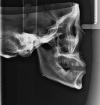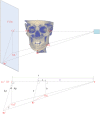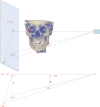Comparison of linear measurements between CBCT orthogonally synthesized cephalograms and conventional cephalograms
- PMID: 25029593
- PMCID: PMC4170847
- DOI: 10.1259/dmfr.20140024
Comparison of linear measurements between CBCT orthogonally synthesized cephalograms and conventional cephalograms
Abstract
Objectives: The purposes of the study are to investigate the consistency of linear measurements between CBCT orthogonally synthesized cephalograms and conventional cephalograms and to evaluate the influence of different magnifications on these comparisons based on a simulation algorithm.
Methods: Conventional cephalograms and CBCT scans were taken on 12 dry skulls with spherical metal markers. Orthogonally synthesized cephalograms were created from CBCT data. Linear parameters on both cephalograms were measured via Photoshop CS v. 5.0 (Adobe(®) Systems, San Jose, CA), named measurement group (MG). Bland-Altman analysis was utilized to assess the agreement of two imaging modalities. Reproducibility was investigated using paired t-test. By a specific mathematical programme "cepha", corresponding linear parameters [mandibular corpus length (Go-Me), mandibular ramus length (Co-Go), posterior facial height (Go-S)] on these two types of cephalograms were calculated, named simulation group (SG). Bland-Altman analysis was used to assess the agreement between MG and SG. Simulated linear measurements with varying magnifications were generated based on "cepha" as well. Bland-Altman analysis was used to assess the agreement of simulated measurements between two modalities.
Results: Bland-Altman analysis suggested the agreement between measurements on conventional cephalograms and orthogonally synthesized cephalograms, with a mean bias of 0.47 mm. Comparison between MG and SG showed that the difference did not reach clinical significance. The consistency between simulated measurements of both modalities with four different magnifications was demonstrated.
Conclusions: Normative data of conventional cephalograms could be used for CBCT orthogonally synthesized cephalograms during this transitional period.
Keywords: Cone beam computed tomography; measurement; orthodontics.
Figures











References
-
- Mozzo P, Procacci C, Tacconi A, Martini PT, Andreis IA. A new volumetric CT machine for dental imaging based on the cone-beam technique: preliminary results. Eur Radiol 1998; 8: 1558–64. - PubMed
-
- Hilgers ML, Scarfe WC, Scheetz JP, Farman AG. Accuracy of linear temporomandibular joint measurements with cone beam computed tomography and digital cephalometric radiography. Am J Orthod Dentofacial Orthop 2005; 128: 803–11. - PubMed
-
- Berco M, Rigali PHJr, Miner RM, DeLuca S, Anderson NK, Will LA. Accuracy and reliability of linear cephalometric measurements from cone-beam computed tomography scans of a dry human skull. Am J Orthod Dentofacial Orthop 2009; 136: e1–9. - PubMed
-
- Hans MG, Valiathan M, Palomo JM. Cone beam computed tomography: a link with the past, a promise for the future. Semin Orthod 2011; 17: 81–7.
LinkOut - more resources
Full Text Sources
Other Literature Sources

